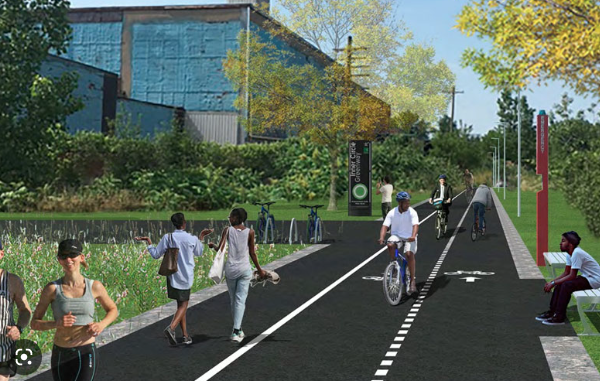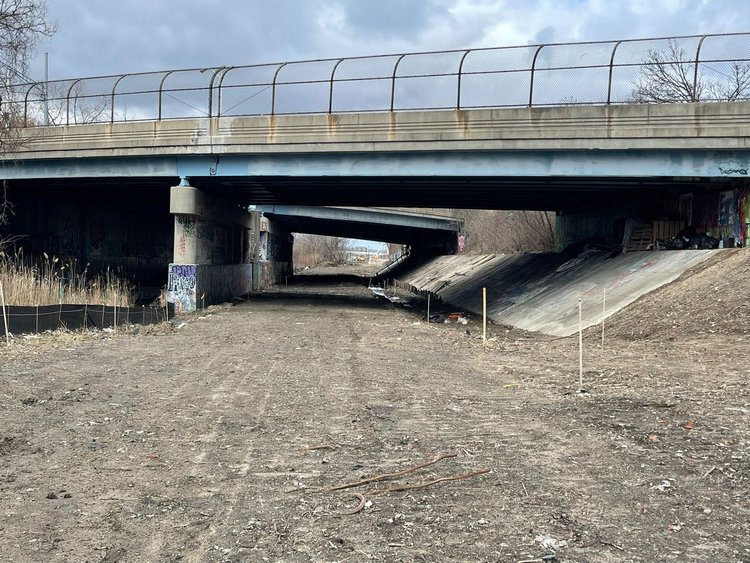Joe Louis Greenway Project Aims to Transform Abandoned Rail Corridor into 27.5-Mile Recreational Pathway

The Joe Louis Greenway is a 27.5-mile pathway that will connect 23 neighborhoods and the cities of Detroit, Hamtramck, Highland Park, and Dearborn to each other and to the Detroit riverfront, Dequindre Cut, Belle Isle, pedestrian/cyclist crossings at the Ambassador and Gordie Howe International bridges, and other trails. Upon completion, more than 40,000 residents will be able to walk to the greenway within 10 minutes. The project is based on a Framework Plan funded by the Ralph C. Wilson, Jr. Foundation and shaped by voices from the community. The General Services Department team led 14 community meetings and attended more than 40 other events and meetings to gather feedback from residents to create the plan. The project is being recognized for its focus on inclusion, and for bringing a wide range of voices to the table while fostering citizen advocacy and activism. In October, The American Planning Association awarded the 2022 Advancing Diversity and Social Change in Honor of Paul Davidoff Award to the project. The greenway has received significant state and federal funding. And earlier this month, the city of Detroit, Detroit Riverfront Conservancy, and Joe Louis Greenway Partnership announced the Unified Greenway Partnership, an alliance that will raise funds to complete the Detroit Riverfront from Belle Isle to the Ambassador Bridge, build the Joe Louis Greenway around the city, and endow both projects for long-term management. SBN Detroit spoke to Brad Dick, COO for the City of Detroit, about inclusion, the use of space for social justice, and the greenway’s potential impact on area businesses and new business development. Q: There is a significant amount of funding from different entities coming in for the greenway. What are your thoughts on the ‘investment in urban spaces’ and the implications this has on small businesses in the area, as well as the opportunities this represents for new business development? A: The Joe Louis Greenway (JLG) is a historic investment across multiple cities and neighborhoods, including Detroit, Highland Park, Hamtramck, and Dearborn. The greenway will transform a blighted, abandoned rail corridor into a beautiful park running through Detroiters’ backyards. To date, the project has removed more than 68,000 cubic yards of debris (which could fill 22 Olympic-sized swimming pools) and nearly 23,000 old, illegally dumped tires from the area, and is investing in permanent infrastructure and beautification that enhances the quality of life and provides equitable access to public resources. Investment in urban spaces brings communities together and provides economic opportunities for local entrepreneurs and businesses to grow and expand, creating jobs, and economic growth, as well as wealth-building opportunities for our residents along the greenway itself and in adjacent communities. Our goal is to make this greenway a destination, which will attract people from all over the region, creating a strong market for existing and new small businesses. The greenway will also provide safe routes, and comfortable connections for both employees and business owners to get to work. Q: How has this project established itself as a model for neighborhood stabilization and for addressing community-based issues as it pertains to social justice? A: Residents have been at the core of the planning process for the Joe Louis Greenway, and hundreds of Detroiters attended community meetings held as part of the Joe Louis Greenway Framework Plan. The Joe Louis Greenway Citizen Advisory Council helped guide the planning process and continues to advocate for the Greenway. The group of dedicated individuals that guided the Framework Plan represented all seven of Detroit’s Council Districts, as well as residents of Highland Park, Dearborn, and Hamtramck, which also touch the Greenway. Joe Louis worked tirelessly to advocate for the rights of Black Americans and to promote social justice in the United States. The Greenway is more than a tribute to his legacy. It celebrates Joe Louis as a role model and as someone whose values can guide this project and the Detroiters it brings together. Q: What are the equitable economic development benefits of this project? A: The JLG is about access – including access to opportunity. Intentional planning, outreach, and action will create economic opportunity for residents in every neighborhood that the Joe Louis Greenway touches. The economic development benefits will include blight reduction and beautification, housing stabilization, preservation of affordable housing, job training, and career opportunities, existing and new small business support, and light industrial development opportunities. The Neighborhood Planning Study, led by Planning and Development Department, will continue the dialogue with the community and focus on opportunities for community and economic development along the Greenway. Q: How will the Neighborhood Planning Study support social justice as well as economic and business/job opportunities? A: As Mayor Mike Duggan has said, the impact of this greenway will extend far beyond the boundaries of the path itself, creating opportunities for Detroiters to thrive. When complete, the greenway will generate jobs and affordable housing opportunities, and ease mobility barriers that have challenged Detroiters for decades. It also will help Detroiters build generational wealth for homeowners by increasing their property values through the beautification and economic investment that the greenway will bring to their neighborhood. Throughout the planning process, residents voiced a need to heal long-standing urban trauma, particularly concerning urban renewal that ultimately displaced Black residents who called those neighborhoods home and whose businesses were torn down. By acknowledging that past trauma, promoting dialogue, and providing new opportunities for healing, the greenway can be a place where Detroiters advance a better understanding of racial justice. Q: How is the greenway helping to build a more sustainable Detroit? A: The design of the greenway incorporates stormwater management to reduce flooding impacts, native meadow plantings to provide bird habitat, and trees throughout to provide shade and help with air quality. Sustainability, however, goes much further than just the environment. This project will impact many facets of sustainability, including public health, economic development, neighborhood stabilization, park access, and connectivity. The Framework Plan ensures that the Joe Louis Greenway will transform the infrastructure that previously divided neighborhoods into one that unites community and reconnects natural systems, catalyzes economic redevelopment, and supports a resilient social network. The
Detroit Greenways Coalition’s Todd Scott Talks Greenways and Sustainability

The Detroit Greenways Coalition (DGC) works to promote and build a network of greenways, Complete Streets, and bike lanes that will connect people and places, improve the quality of life, beautify neighborhoods, and stimulate neighborhood-level economic development in Detroit. Its mission is to create, conserve and promote greenways and green spaces to connect people, places, and nature. Its vision is a strong, healthy, vibrant City of Detroit and a region where a seamless network of greenways, green spaces, blueways, and Complete Streets are an integral part of people’s active lifestyles including day-to-day transportation and recreation. SBN Detroit spoke to DGC Executive Director Todd Scott to gain insights about their work. Q: How big of a driver was sustainability for the city of Detroit in the forming of the Greenways Coalition? A: In the beginning, we had to tackle more basic issues about how to build and maintain greenways across the entire city and how to make green transportation easier and safer. Our vision was certainly supporting sustainable transportation and green space, but we were focused initially on more basic issues. Some examples here are developing a citywide greenway network vision, advocating for redesigned city streets that better accommodate green transportation, and finding the resources to make this all a reality. Over time we’ve been able to move beyond these issues and push sustainability more, especially in light of the need for Climate Action – reducing transportation carbon emissions and providing green stormwater management. Q: The vision of the Greenways Coalition is ultimately to connect every neighborhood over time. Please speak to how this impacts the city in terms of sustainability from these aspects: Environmental: Greenways and Complete Streets (i.e. streets designed to safely accommodate all users) can do more than provide green transportation. They can help manage stormwater through green stormwater infrastructure, street trees, and even de-paving roads. They can also reduce urban heat island effects. Flooding and extreme heat are big issues in Detroit that our work can help address. Transportation/Mobility: The most important impact is how these connections help Detroiters use green transportation. That’s not just walking and biking, but public transit as well. They provide safe and convenient routes that connect schools, jobs, parks, retail areas, and more. Economic: There are many examples of greenways and Complete Streets driving economic urban revitalization around the world. Locally, there may be no better example than the Livernois Avenue of Fashion. The streetscape project reduced vehicle travel lanes (and speeding), widened sidewalks, and added bike lanes. Businesses along the route have flourished. There is a tremendous opportunity for additional retail revitalization along the 27-mile Joe Louis Greenway. It will be interesting to see how places like the Oakman/Grand River strip and even Downtown Hamtramck increase business activity as a result of the greenway and the bike and pedestrian traffic that it brings. Social/Inclusivity: Biking and walking can be very social. We’ve seen this with the numerous biking and walking clubs that have formed across the city over recent years, but especially during COVID. Greenways and Complete Streets support these club events that are open to everyone. Q: Does the Greenways Coalition have a set of sustainability goals? A: What we largely do is advocate for institutions to have sustainability goals. We’ve done that with the City of Detroit through their Sustainability Action Agenda. We’ve been heavily involved in the carbon neutrality discussion at the state level through the MI Healthy Climate Plan. We’ve even weighed in on federal issues, such as the recently proposed U.S. DOT Greenhouse Gas Emissions rule. You could say our agenda is to get sustainability incorporated at the institutional level so that it leverages the benefits of our vision. Q: From a sustainability standpoint what are the direct benefits the Greenways offer to Detroit residents? A: The largest direct sustainability benefit is transportation. Greenways provide “green ways” to get to destinations around the city and to connect with public transportation. The “green” in greenways has multiple meanings. It’s more than just landscaping, it’s about sustainable transportation. It’s also about saving some “green,” e.g. money. Sustainability can benefit Detroiters, but that benefit must also improve the financial sustainability of the household budget. Vehicle transportation can eat up a large portion of that budget. Greenways can benefit many and reduce that burden. Be sure to subscribe to our newsletter for regular updates on sustainable business practices in and around Detroit.


